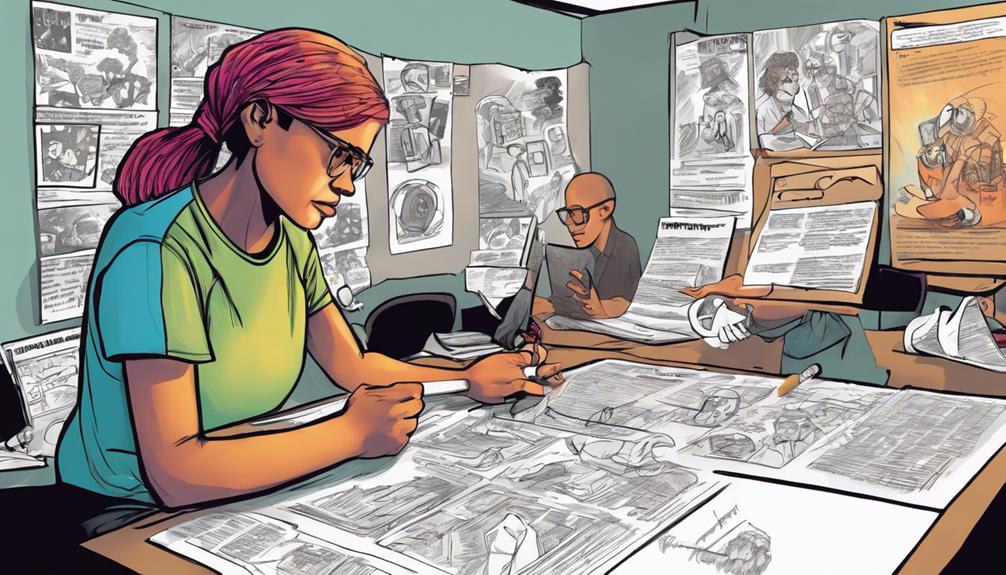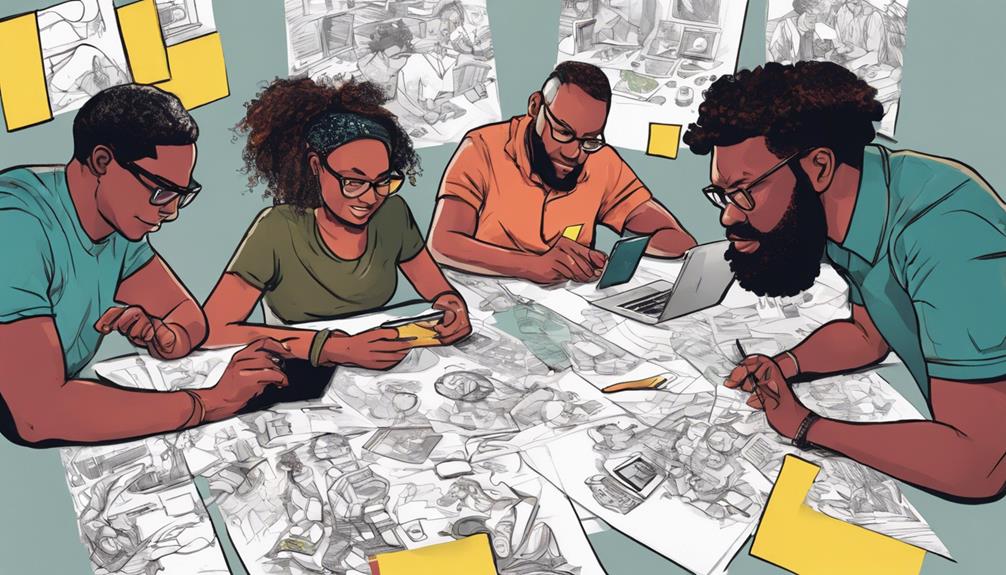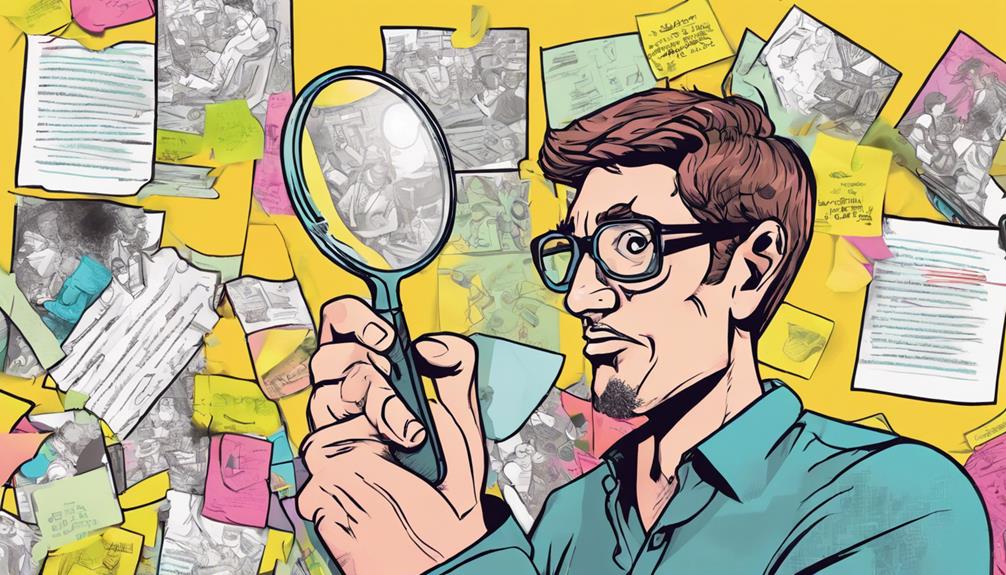Scale innovation within your organization by implementing Enterprise Design Thinking. Prioritize user outcomes, build diverse empowered teams, and embrace rapid prototyping. Use the Loop of Innovation for structured observation and reflection, minimizing risk while achieving human-centered outcomes. Align your team with user objectives through Hills, Playbacks, and Sponsor Users. This approach will drive innovation, foster collaboration, and enhance customer satisfaction. Speed up your prototyping process with efficient collaboration tools like UXPin Merge. Enhance collaboration, streamline workflows, and accelerate innovation. Learn more about Design Systems Importance, Application Insights, and strategies for Speeding Up Enterprise Innovation to further drive organizational success.
Key Takeaways
- Ensure teams align with user objectives for innovation scaling.
- Promote a culture of design thinking for quick prototyping.
- Foster collaboration through diverse empowered teams.
- Implement Agile methodologies for adaptive adjustments.
- Encourage cross-functional teamwork for innovative solutions.
Framework Principles
Within the Enterprise Design Thinking framework, the guiding principles emphasize a user-centric focus, encouraging you to prioritize user outcomes above all else. By keeping the user at the center of your innovation process, you guarantee that your solutions truly meet their needs and desires.
Additionally, the framework highlights the importance of diverse empowered teams, empowering you to collaborate with individuals from various backgrounds and perspectives to drive creativity and innovation.
One key strategy within Enterprise Design Thinking is rapid prototyping. This approach encourages you to quickly create and test prototypes of your ideas to gather valuable feedback and iterate on your designs efficiently. By embracing rapid prototyping, you can accelerate the innovation process and bring solutions to market faster than traditional development methods.
The Loop of Innovation
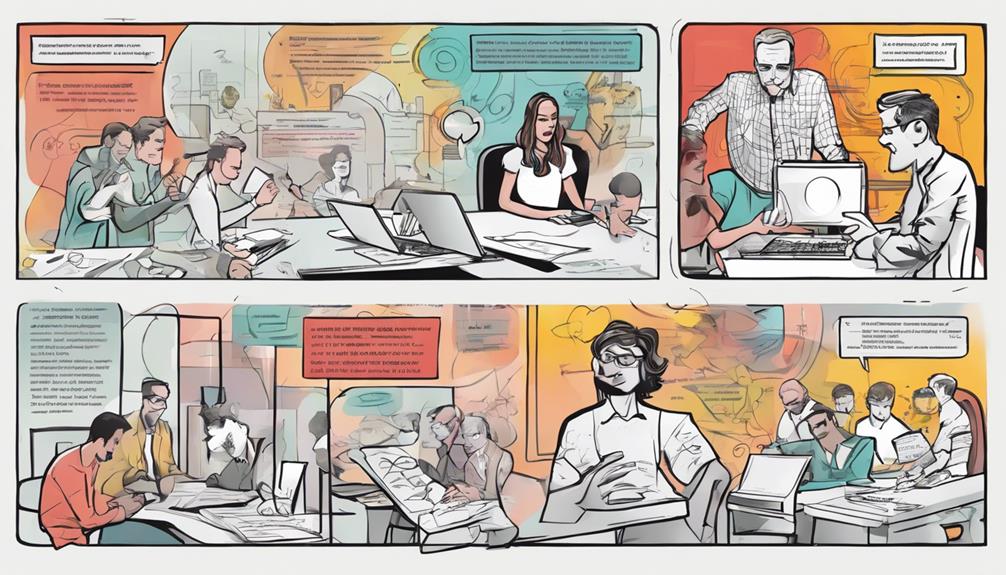
Embrace the iterative process of The Loop of Innovation, which involves observing, reflecting, and making to drive breakthrough solutions. This structured approach within Enterprise Design Thinking is pivotal for minimizing risk and achieving innovation.
By following The Loop, you gain insights into user challenges, synthesize findings, and test hypotheses effectively. The key components of The Loop—observation, reflection, and rapid prototyping—work cohesively to propel human-centered outcomes and help in achieving user goals within an Enterprise setting.
Observation plays a vital role in understanding user needs and behaviors, while reflection aids in synthesizing these observations into actionable insights. Rapid prototyping allows for quick iteration and testing of ideas, fostering a culture of experimentation and innovation.
Team Alignment Strategies

Team alignment strategies such as hills, playbacks, and sponsor users are essential components in promoting a focused approach on user objectives and progress evaluation within Enterprise Design Thinking.
- Hills: Define user goals and guide the team towards a common purpose in the design process.
- Playbacks: Help in assessing progress by showcasing prototypes and receiving feedback from stakeholders.
- Sponsor Users: Provide deep expertise and insights to enrich the design thinking process.
- User-Centric Approach: These alignment strategies help maintain a user-centric approach, fostering collaboration and driving innovation within teams.
Implementing these strategies promotes that the team stays aligned with user needs and project objectives. By defining clear goals through hills, receiving feedback through playbacks, and leveraging the expertise of sponsor users, teams can enhance their design process and deliver solutions that truly meet user requirements.
This collaborative and focused approach not only drives innovation but also promotes that the end product or service resonates with the intended user base.
Benefits for Organizations
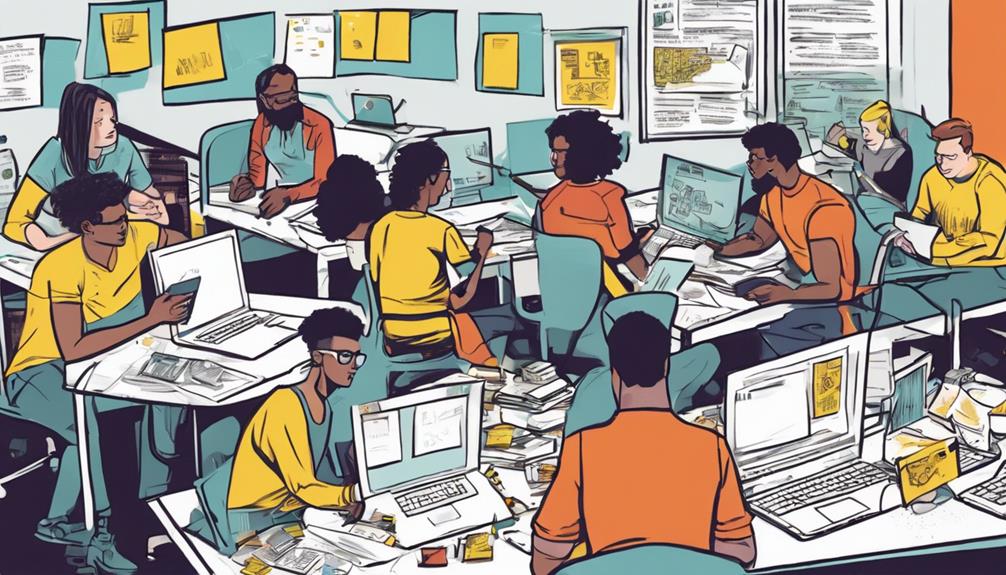
To reap the benefits of Enterprise Design Thinking, organizations can harness customer input, foster collaboration, and drive innovation to create tailored solutions and enhance customer satisfaction. By focusing on user outcomes and involving customers in the innovation process, organizations can make sure that their products and services meet the needs and expectations of their target audience.
Additionally, Enterprise Design Thinking breaks down silos within organizations by promoting collaboration among diverse empowered teams. This collaborative approach fosters creativity and drives breakthrough solutions that may not have been possible in traditional hierarchical structures.
The principles of relentless reinvention and diverse empowered teams inherent in Enterprise Design Thinking enable organizations to stay agile and continuously innovate, leading to meaningful and impactful solutions. Implementing Enterprise Design Thinking not only results in faster time-to-market and reduced costs but also yields a higher return on investment for organizations looking to scale their innovation efforts.
Application Insights

You're about to explore essential insights on Scaling Innovation Strategies, Implementation Challenges, and Success Stories.
These points will shed light on how Enterprise Design Thinking can drive transformative outcomes within organizations.
Get ready to uncover practical applications and real-world examples that showcase the power of this innovative approach.
Scaling Innovation Strategies
When scaling innovation strategies within an organization, applying Enterprise Design Thinking principles can help drive successful application insights. Here are four key strategies to take into account:
- Ensure Teams Move Together:
Encourage teams to move swiftly through the design thinking process, iterating on ideas, and validating assumptions with real users to foster continuous innovation.
- Stay Aligned with User Objectives:
Keep teams aligned with user objectives using frameworks like Keys, which include Hills, Playbacks, and Sponsor Users to make sure everyone is driving towards tangible outcomes.
- Embrace Thinking in the Enterprise:
Foster a culture of thinking in the enterprise by encouraging diverse empowered teams to collaborate and contribute innovative ideas that align with user needs.
- Utilize Loop Visualization:
Implement the Loop visualization method to observe, reflect, and rapidly prototype ideas, enabling breakthrough innovations and keeping the focus on user-centric solutions.
Implementation Challenges
Scaling design thinking within an organization presents challenges in implementing user-centered practices beyond UX teams. Overcoming resistance to change is necessary for successful implementation.
To achieve this, it's crucial to spread user-centered practices throughout the entire organization. Understanding the benefits of design thinking and identifying influential points within the company are starting points for implementation.
Adapting design thinking to suit different industries is also vital. By ensuring continuous innovation and improvement, you can maintain the momentum of design thinking initiatives.
Leadership engagement plays an important role in pitching the benefits of design thinking, educating leadership on its importance, and fostering an employee fanbase to support successful implementation.
Success Stories
Successful organizations like GE Healthcare, Bank of America, and Intuit have leveraged design thinking to drive transformative user experiences, showcasing tangible impacts on their bottom line and customer satisfaction.
When looking at these success stories, you can observe the following key points:
- Improved Patient Care: GE Healthcare utilized design thinking to enhance patient care experiences, leading to better outcomes and increased satisfaction among healthcare providers and patients.
- Enhanced Customer Engagement: Bank of America successfully applied design thinking principles to improve customer engagement strategies, resulting in higher levels of customer satisfaction and loyalty.
- Streamlined Financial Services: Intuit leveraged design thinking to streamline its financial services, making processes more efficient and user-friendly for customers.
- Leadership Engagement and Organizational Adaptation: These organizations prioritized leadership engagement and organizational adaptation to scale design thinking effectively, fostering a culture of continuous innovation and user-centered practices.
UXPin Merge Impact

UXPin Merge can greatly speed up your prototyping process, enhance collaboration in design, and streamline your design-to-development workflow.
This tool has proven its worth at PayPal, where it helped scale design efforts efficiently without expanding the team.
Speeding up Prototyping Process
By leveraging UXPin Merge, you can expedite your prototyping process, enabling quicker iterations and collaboration for more effective product development.
Here's how UXPin Merge impacts the speed and scale of your design thinking process:
- Quicker Iterations: With UXPin Merge's code-based design capabilities, you can swiftly iterate on prototypes, incorporating feedback and making changes in real-time.
- Efficient Collaboration: The tool facilitates seamless collaboration between designers and developers, ensuring that everyone is on the same page and working towards a common goal without delays.
- Streamlined Workflows: UXPin Merge bridges the gap between design and development, eliminating bottlenecks in the process and allowing for smoother progress from prototype to final product.
- Improved Time-to-Market: By reducing design time significantly, as seen in PayPal's case study, you can accelerate your product development cycle and get your innovations to market faster, gaining a competitive edge.
Enhancing Collaboration in Design
Enhancing collaboration in design becomes seamless and efficient with the integration of UXPin Merge, fostering stronger teamwork and faster iteration cycles for your enterprise. By leveraging this advanced design tool, you can enhance collaboration between your design and development teams, ultimately scaling innovation within your organization. PayPal's success story showcases how UXPin Merge can bridge the gap between design and development, leading to more meaningful collaboration and efficient scaling of design efforts.
To highlight the impact of enhanced collaboration through UXPin Merge, consider the following:
| Benefits | Description |
|---|---|
| Improved Communication | Streamlined communication channels between design and development teams. |
| Faster Iteration Cycles | Accelerated design iteration cycles, leading to quicker product development. |
| Seamless Workflow | Integration of design and development processes for a more seamless workflow experience. |
With these advantages, using UXPin Merge can substantially boost collaboration, streamline processes, and drive innovation at scale within your enterprise.
Streamlining Design-To-Development Workflow
Improving collaboration and efficiency in design-to-development workflow is pivotal for scaling innovation within your enterprise, with the impactful integration of UXPin Merge. By leveraging this code-based design tool, you can enhance your product development processes and drive innovation effectively.
Here's how you can streamline your design-to-development workflow with UXPin Merge:
- Accelerate Prototyping: Utilize UXPin Merge to speed up the prototyping phase, allowing for quick validation of design concepts and iterations.
- Enhance Collaboration: Facilitate seamless communication between design and development teams, fostering a more cohesive working environment and reducing misunderstandings.
- Reduce Time-to-Market: With UXPin Merge, you can expedite the design-to-development cycle, enabling faster product launches and staying ahead of the competition.
- Gather Meaningful Feedback: Leverage the capabilities of UXPin Merge to gather valuable insights from stakeholders and users, ensuring that your product meets their needs and expectations efficiently.
Design Systems Importance

Design systems play an important role in ensuring consistency and efficiency in design solutions across an organization. By providing a central repository of design elements, guidelines, and principles, teams can work cohesively to create diverse, empowered design solutions for users and clients. These systems streamline the design process, reduce redundancy, and ensure brand consistency. Collaboration between design and development teams is improved, leading to faster and more effective product delivery. Implementing design systems can result in increased productivity, improved user experience, and reduced design debt.
| Design Systems Benefits | |
|---|---|
| Consistency & Efficiency | Central Repository |
| Streamlined Processes | Improved Collaboration |
| Increased Productivity | Enhanced User Experience |
| Brand Consistency | Reduced Design Debt |
Stay Updated With UXPIN

To stay informed about the latest updates and design insights, follow UXPin on social media platforms like Twitter and Dribbble.
Here are four reasons why staying connected with UXPin is beneficial for design professionals:
- Real Insights: UXPin provides real-world insights into design systems and DesignOps, helping you stay ahead in the ever-evolving design landscape.
- Diverse Perspectives: By following UXPin, you gain access to different perspectives on team structuring, hiring tips, and design challenges from DesignOps leaders.
- IBM's Approach: Learn about enterprise design thinking and scaling innovation by exploring UXPin's content curated to reflect IBM's approach to design.
- Free Resources: Access free trials and e-books on design systems and DesignOps, empowering you with valuable resources to enhance your design processes.
Speeding Up Enterprise Innovation

Establishing clarity and focusing resources on viable initiatives can significantly accelerate enterprise innovation. By incorporating design thinking into your innovation process, you can streamline the development of new solutions. This approach emphasizes empathizing with users, defining problem statements, ideating potential solutions, prototyping rapidly, and testing iteratively. By following this structured design thinking process, you can guarantee that your innovation efforts are targeted and efficient.
Furthermore, fostering a culture of innovation within your organization and encouraging collaboration among teams can expedite the generation of fresh ideas. Investing in training and development for your employees can also enhance their confidence in exploring new concepts and pushing boundaries. Implementing agile methodologies for quick prototyping can further expedite the innovation process, allowing you to test ideas rapidly and make necessary adjustments on the fly.
Additionally, promoting cross-functional teamwork to gather diverse perspectives can lead to more innovative and robust solutions in enterprise settings.
Frequently Asked Questions
Can Design Thinking Be Used for Innovation?
Yes, design thinking can fuel innovation by fostering creativity, empathy, and user-centric solutions. It's a proven methodology for addressing complex challenges and driving growth. Embrace it to transform your organization and scale innovation effectively.
What Are the 4 Questions in the Innovation Process of Design Thinking?
Explore the 4 questions in the design thinking innovation process: What is? What if? What wows? What works? Uncover problems, brainstorm creatively, aim for wow experiences, and validate solutions. Iteratively answering drives innovation and user-centric solutions.
What Are the Three Principles of Enterprise Design Thinking?
Explore deep into the three principles of enterprise design thinking – user outcomes, restless reinvention, and diverse empowered teams. Embrace these pillars to drive innovation, foster creativity, and achieve breakthrough solutions in your organization.
What Is a Relationship Between Design Thinking and Innovation?
Design thinking and innovation are interconnected, with design thinking serving as the foundation for innovative solutions. By applying principles like empathy and prototyping, you can generate breakthrough ideas that drive real-world change and foster growth.
Conclusion
To wrap up, embracing enterprise design thinking is like adding fuel to the fire of innovation within your organization.
By implementing the principles and strategies outlined in this article, you can scale innovation and drive meaningful change.
So, don't be afraid to think outside the box and push the boundaries of what's possible – the sky's the limit!


